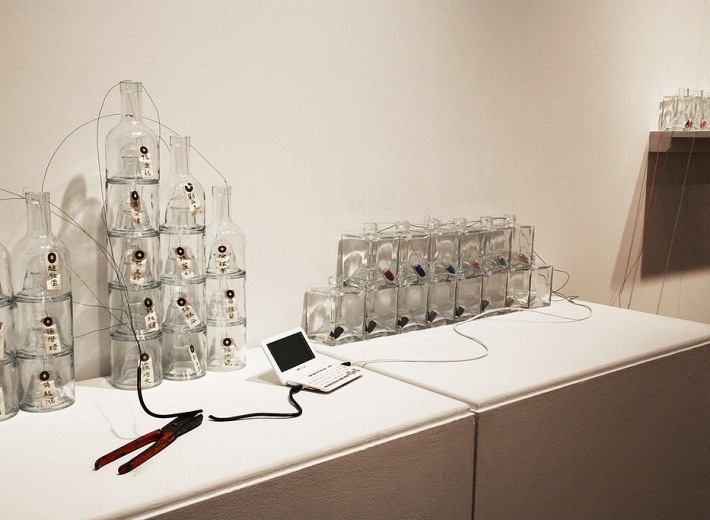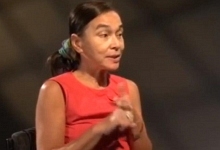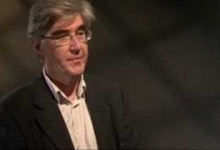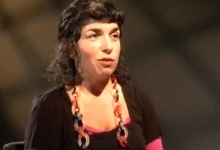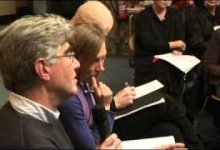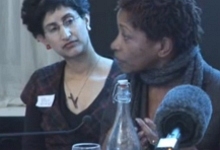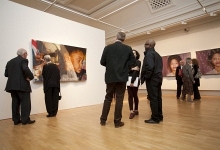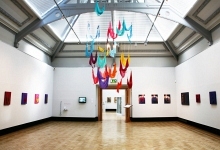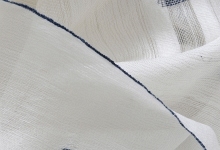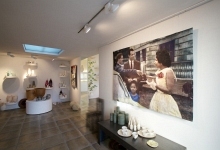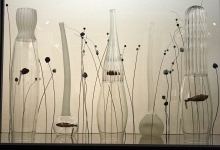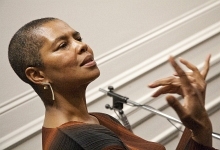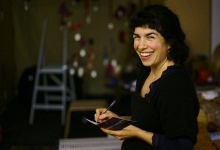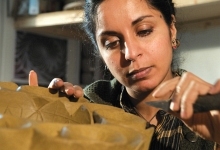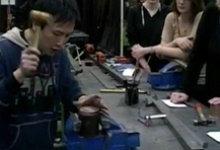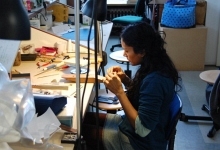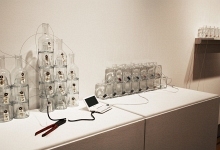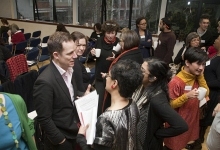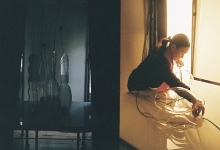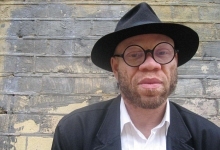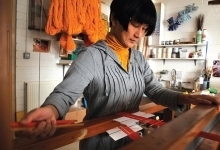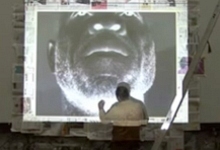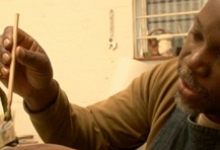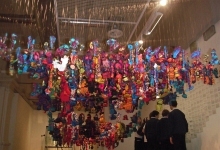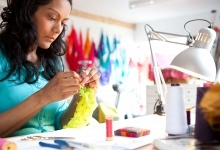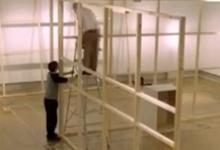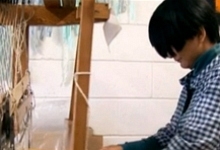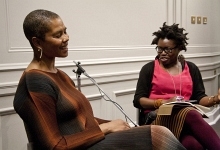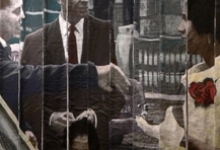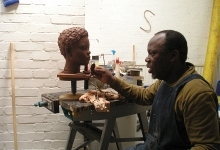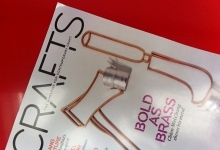Over the period which the shape of things operated several people contributed blogs to the original website. These are reproduced below
Alia Ullah & Ruqqia Ullah - Threads and Jewels
Through our work we aim to create an awareness of embroidery as a craft through rejecting a passive attitude and challenging its current perceptions. We want to open the critical debate of slave labour expressing our frustration at the moral injustice of women and children in South Asia working in appalling conditions creating embroidered items for our consumption.We believe their is a need for ethical practices in embroidery and textiles and we do this by hand embroidering items ourselves as well as actively using recycled and renewable fabrics.
We are concerned with issues of cultural heritage and identity because of our cultural roots as second generation British Pakistani Muslim women. Our work also opens the critical debate related to the political conundrum that is contemporary interculturalism through challenging our own identities as British with cultural roots in South Asia (mainly Pakistan) and the Middle East. Our work also explores the history of migration that took place in the 1950s through to the 1960s by laborers from the British colonies – especially South Asia who came to work in the North West to work in the flourishing textile trade. Our work challenges perceptions of British national identity as it is an exploration of a variety of global world cultures.
As well as working as artists we work as creative practitioners devising and carrying out textile art workshops from our own artworks and artistic practice. We also organise ‘Community Crafts’ events in venues around Manchester promoting and highlighting craft artists in local Manchester based communities. Our ‘Community Crafts’ events are an opportunity to socialize and meet craft artists across the North West providing a local network that engages with the community. We have our own craft based business under the name Threads and Jewels where we produce wearable textiles which are distributed through outlets across the North West. For more information on what we do, what we’re up to and upcoming events check out our website: www.threadsandjewels.com
September 2010
The Making of Things - Dr. Bharti Parmar
Dr. Bharti Parmar attended the Contemporary Art Society’s Annual Member’s Conference The Making of Things at the Victoria Gallery and Museum, University of Liverpool on 18 February 2011 and wrote a report for the shape of things’ website:
Background of Contemporary Art Society/National network - “The National Network is a membership programme for art professionals who are working with collections of contemporary art or who have a particular interest in public collections in this country. The programme offers seminars, skills days, events, national and international trips and now an Annual Conference. It is the only UK-wide programme that focuses on the many issues that lie at the heart of our work in growing, sustaining and using public collections of contemporary art.” (quote from cover sheet of Contemporary Art Society Annual Members Conference programme)
Objective of conference - The Contemporary Art Society National Network Annual One-Day Conference was organised around the following question:
“How are collections of applied art and craft framed within the context of the museum collection?”
“The conference will raise a number of issues relating to craft and applied art with a focus on dynamic use of collections, collection development, exhibition making and the concerns of the artist.”
Delegates - 59 delegates were listed representing a range of national and regional arts organisations such as The National Trust, Blue Coat Display Centre Liverpool and PaisleyMuseum and ArtGalleries. A number of academics and independent artists also comprised the audience (like myself) combined with a number of research and undergraduate students (the latter from the city’s universities). Yvonne Hardman, a TSOT representative from Touchstones Rochdale was also present.
Structure of Day - The day was organised into two halves with the first half appearing to focus on cross-cultural issues pertaining to creative interpretation of craft in museum collections.
The afternoon featured case studies of individual artists and their personal responses to commissioned work within such museum settings. After each section, a panel led discussion on themes raised which were then opened to the audience.
Speakers - The scope of speakers was impressive with the keynote address scheduled to be led by Professor Jyotindra Jain, cultural historian and former Director of the NationalCraftsMuseum, New Delhi. However, due to ill health, his presentation was screened as a filmed interview of his research interests. Other speakers included curators Divia Patel (Asian Dept V&A), Grant Watson (Iniva), Glenn Adamson (Deputy Head of Research and Head of Graduate Studies V&A) and Neil Brownsword (ceramic artist) plus several others.
Summary of proceedings - Jyotindra Jainset the tone for the conference providing the context of Indian handicrafts and artisanry. He made erudite observations on craft during his long career, explaining how his background as an anthropologist informed his thinking throughout his work with the tribal ritual arts of India. By using anecdotal evidence he explored concepts of narrative in painting, innovation, iconography and hybridity. His main thrust was that after Indian Independence in 1947 there was a shift for rural crafts of A RITUAL TRADITION (textiles, pottery, painting in particular) to become mass-manufactured, i.e. paintings on walls and floors were transferred onto paper, hence creating an economic market. He then went on to explore craft as a vehicle for social change, especially for women of no economic power. He concluded by discussing contemporary Indian crafts, the art market in India and relationships between tribal and contemporary arts.
After Professor Jain’s film, curators from the first panel discussed their various exhibition and curatorial strategies loosely formulated around artisanry and the object.
Morning:
· Grant Watson (Iniva) discussed his curated exhibition at MuHKA, Antwerp entitled The Social Fabric in which artists deployed textiles to discuss complex social meaning.
· Divia Patel (V&A) described India: Design Now in which contemporary Indian designers from various fields (fashion, architecture, furniture) used an Indian aesthetic that focussed particularly on the handmade.
· Eleanor Bradshaw, a curating student and Inspire Fellow at the BritishMuseum discussed her work selecting objects in archives with Grayson Perry for his forthcoming exhibition at the BritishMuseum about the role of the craftsman
Afternoon:
· One of the most exciting contributions was by Glenn Adamson (V&A). Entitled The Invention of Craft, his paper provided theoretical frameworks to the day through his investigation of craft and innovation. His presentation, which privileged the mechanics of craft (i.e. the hand and its vocabulary) suggested ways in which to understand not only the reception of craft but its conception through reflection upon subtle metaphors in its making. This presentation provided an excellent foil to Professor Jain’s reflections upon innovation and invention in the tribal arts context.
· Following this presentation, the curator Andrew Renton (National Museums Cardiff) and artists Neil Brownsword, Fiona Jardine and David Cushway talked about their experiences of working within museum settings with established collections and the successes and failures of their interventions within them.
Plenary - During the round up for the day, the contributors addressed the conference question regarding the framing of craft within museological contexts and what has been learned by these various experiences. Responses ranged from the technical
(i.e. new ways to display existing collections) to the emotional and cerebral (do museums need go-betweens?, is it necessary to have artists interpreting everything?) In summary, it was generally agreed that both artists and host cultural institutions mutually benefitted from their collaborations resulting in new and richer interpretations of the historical artefact.
Questions - Sadly, due a lack of dynamic between panel and audience and no discernable chair, very few people asked questions.
Following on from the keynote film by Professor Jain, I raised one point to the panel consisting of Divia Patel and Grant Watson about hybridity and cultural expression of UK artists: “To what extent is the panel committed, within their critical thinking, their curatorial practice and collection policy, to work with contemporary artists born in the UK but whom may have had a diasporic experience and how to represent this ‘cultural capital’ for future work?”
Taking into account that panels do not know in advance what they might be questioned on, I felt this rather obvious question, given the panel’s expertise, was somewhat patchily answered.
Private View - An evening reception took place at Ceri Hand Gallery and was attended by about 20 delegates. Director Ceri Hand gave a very impressive presentation of the UK art market, her role as director of the only privately funded commercial contemporary art gallery in Liverpool, and the work of her artists before an informal viewing of the current exhibition by artist Doug Jones. The evening was a very successful event providing a valuable networking opportunity and a resolution to the conference.
Dr. Bharti Parmar info@bhartiparmar.com www.bhartiparmar.com
11 March 2011
Momtaz Begum-Hossain - What is Craft?
Momtaz Begum-Hossain is a Freelance Writer and craft enthusiast. In her spare time she dabbles in textiles and in 2010 undertook an apprenticeship in hand weaving giving her a chance to experience life as a full time maker/designer. She blogs at www.CosILikeMakingStuff.Blogspot.com She was asked to write about craft in the context of the shape of things for the website to stimulate debate.
What is Craft?
I am a writer and forming sentences is my craft. They are my response to thoughts, feelings and ideas. When I record words, I create something; a tangible paragraph that no one else can replicate. It may not be considered a ‘craft’ in the typical sense but to me, writing embodies ‘craft’ just as much as a piece of hand-blown glass. Anything that is unique and has been made by an individual should be considered a craft. Similarly mass produced ceramic plates, reams of cloth printed in a factory and identical jewellery sets bought from The Argos catalogue should not be defined as craft.
Confusingly there are many sub categories of craft: ‘traditional craft’ ‘contemporary craft’, ‘homecrafts’ ‘hipcrafts’, ‘mastercrafts’, it’s not surprisingly when you say the word ‘craft’, people only half understand what you’re talking about. It’s assumed that the ‘professional mastercrafter’ studied at university or through an apprenticeship and spent years perfecting techniques that have been handed down through generations. The common crafter today is the ‘contemporary crafter’, a graduate with awards and exhibitions under their belt. Their work is a response to traditional crafts with a personal twist. And then there is the homecrafter, the category I fall into alongside my writing.
In my spare time I dabble in crafts - I sew, knit, print, embroider, stitch, mould, fuse, bead and crochet. I aspire to sell my work as a sideline to my main job and I’ve even had the odd market stall where I’ve just about broken even. My work will never be displayed in public or sell for little more than labour and material costs. Does that make me less of a crafter?
Some would argue that ‘standards’ and quality vary between me and my fellow ‘professionals’. The mastercrafter is a perfectionist who would never produce sub standard work. The contemporary crafter is doing something positive for society, educating and increasing involvement in the arts while the amateur homecrafter is largely self-taught, learning skills at evening classes, getting inspiration from books and doesn’t mind if they have the odd dropped stitch. Their work is worth less but perhaps this doesn’t matter because after all, it’s not their livelihood? It is however their passion, and every crafter, whatever their background and experience needs passion as the sole basis for why they do what they do. Like writing, no crafter goes into the field for money.
To appreciate crafts, whether you’re a museum curator or member of the public, you need to have respect for the crafter, understand the relevance of the skills they are displaying and the selflessness and time that went into conceiving and creating it. Yet it feels like craft as a discipline never gets noticed. It’s invisible in galleries and absent in the press. While Banksy’s Urban Drawings are renowned world over for changing the face of modern art, guerrilla knitting is only ever talked about in The Guardian. That’s why it’s important that we invest more time, resources and energy into promoting crafts in the UK. There is an audience out there who would feel engaged and inspired if they saw more of it. The Shape of Things plays a role in this, though it’s focus is on Contemporary Craft, it has the potential to reach out and showcase all aspects of craft. Here on the 'blog' that accompanies the project, I hope others will explore the ‘writer’ in them to express what they think about the discipline, where it’s going and what we can do to help it get the recognition it deserves.
31st August 2011
Comments Submitted (3)
- Jess
12 Sep 11 @ 22:44:49
I think appreciating craft has a lot to do with appreciating the process. Quite often in a gallery if you just walk around and look at an object, with no idea of how it's made or why it's made, it almost feels as though it has a lesser value. But through revealing those processes, of why something is the way it is, or how the artist created something, it holds more meaning. And perhaps that's part of why much of the promotion fails? Because the people who value it, are the people who can look beyond the sometimes superficial aesthetic of an object and appreciate it for the time and work that went into it and quite often, those people are the people who have participated in craft themselves. It seems like, there's an invisible barrier, between objects sitting in a gallery, staged and primped in a specific way, curated within specific themes and the artist who created it, their thought process, innovation, use of materials and techniques. I'm sure many galleries attempt to address this by adding additional information, but does that remove a layer of personalism? Or go against the grain of working with something so tactile and material-led?
- Momtaz
28 Sep 11 @ 11:43:05
Jess, I completely agree with your observations that sometimes you walk around a gallery and because you don't know how an item has been made, it feels like it has less of a value - I'm guilty of that myself. And while galleries do try and tell the story by adding information it doesn't always get noticed. At the moment I'm working with a newly opened windmill in London and this weekend it's opening for the 4th time. They've decided not to have any information visible (having text describing the history seems like the traditional thing to do but as it doesn't always work they are trying their own approach.) Every visitor goes on a 'guided tour' so they get to hear about it (delivered by a person rather than portable headphones.) Although some people may argue there could be language barriers or not everyone wants to be shown around I think it's a very positive approach and I'm sure it will work (I'll see for myself on Saturday!).There are also some very big craft events and exhibitions on at the moment. This week I attended Origin: The Contemporary Craft Fair, a prestigious annual craft event organised by the Crafts Council. For a crafter to be involved, it's a big deal. Although anyone can apply, getting chosen to be there, representing the best in British craft is a huge accomplishment. When I visited two years ago I was astounded by the quality of work on show. It was exceptional work of a high standard; things that would make you say 'wow, that is proper skilled craft' using classic techniques - ceramics, glass, weaving etc. This year the exhibition felt completely different, those crafts were still there in force but there was also alot of what looked like more 'amateur craft.' It was made by 'professionals' but it was as though the focus of the show had changed, that they've now decided to have more homecrafty looking things too. While I think that's a good idea it did make me question this notion of 'what is craft?' again. Origin is supposed to represent the very best in craftsmanship, but now it's more inclusive, is it loosing it's authority? It felt like just another craft fair. Did anyone else visit it and what did you think? Also has anyone seen The Power of Making at the V&AMuseum? That's next on my list!
- Momtaz
01 Nov 11 @ 13:16:29
Last week, I went along to Handmade In Britain at ChelseaTown Hall; a contemporary craft and design fair with the sole purpose of raising the profile of British crafts worldwide. Being based in Chelsea, the clientale (visitor wise) seemed to be very different to the types of people who were visiting last month's Origin. They seemed to be wealthier, very knowledgeable of the 'handmade' and yet the pieces on display were very reasonably priced. I felt many of them could have been on sale for more. It made me wonder about the monetary value of handmade crafts. We know it costs more to produce than mass-made, but are designer/makers having to compromise in order to get sales, by selling their work at prices less than it is actually worth? What effect does this have on the craft industry? Is this something we need to address? I would love to know what designers think about this issue.Incase you want to find out more about Handmade In Britain, there's a coffee table book of all the exhibitors, to help raise their profile further, with images of their work and short essays about them.

